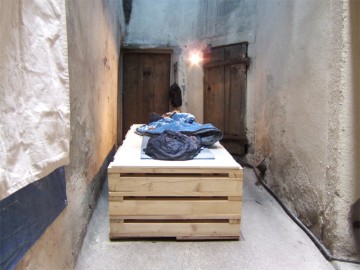Sybille Hotz
hausen
August 25, 2007 – October 13, 2007
“It is the trail of the thread that provides the pictures and objects of Sybille Hotz with meaning and form. Emancipated from her earlier works, the predominantly hand-stitched seams represent more than a substitute and a technical connection between textiles, they are the single most important visual design element. Here, stitch effects stroke. More akin to drawing than to painting, the woollen line pins down the dramaturgy of the picture within the broad alliance of cloth and yarn.” (Rita E. Täuber)
With reference to the global flow of migration and the escalating need for flexibility in an increasingly fast-turning working environment, Hotz presents us, in the project space ‘Ehegraben’, with her conclusion as an artist. The modern/contemporary artist works as a modern nomad: she travels from exhibition to exhibition, sets up her ‘tent’ for a short while, works on-site and exhibits. This mode of practice requires flexibility and a quick reaction to situations and places. The once negative term ‘Business Nomad’ (meaning nowhere-at-home) has developed in the global Internet age to a new term: Flexecutives.
Flexecutives do projects, they are mobile and at home anywhere in the world. Geographical rooting means provinciality and unimportance. On the other hand, a state of permanent transit and an ever-changing (exciting) work environment is a sign of success and prosperity, and so it follows that these modern nomads are no longer of the marginal and homeless but belong to the economic and artistic elite. They have ceased to travel with the clan or together with animals; instead of tents or caravans they dwell in lofts and hotels equipped with laptop, mobile telephone and credit card.
Hotz begins her work with needle and thread. A sleeping bag is machine quilted with various motives that remind her of home and country. With on site available materials she creates needful furniture. A rain/sun roof construction made of coloured building plans serves as protection from the elements. She adapts these plans using scissors, cutting out peepholes that allow a view of the sky.
The Ehegraben, which in medieval times housed pigs that ate the waste of the townsfolk, now allows a new encounter and approach. Sybille Hotz can be found daily in the Ehegraben from Monday to Friday, August 20-24, 2007 and can be visited during her work.
With reference to the global flow of migration and the escalating need for flexibility in an increasingly fast-turning working environment, Hotz presents us, in the project space ‘Ehegraben’, with her conclusion as an artist. The modern/contemporary artist works as a modern nomad: she travels from exhibition to exhibition, sets up her ‘tent’ for a short while, works on-site and exhibits. This mode of practice requires flexibility and a quick reaction to situations and places. The once negative term ‘Business Nomad’ (meaning nowhere-at-home) has developed in the global Internet age to a new term: Flexecutives.
Flexecutives do projects, they are mobile and at home anywhere in the world. Geographical rooting means provinciality and unimportance. On the other hand, a state of permanent transit and an ever-changing (exciting) work environment is a sign of success and prosperity, and so it follows that these modern nomads are no longer of the marginal and homeless but belong to the economic and artistic elite. They have ceased to travel with the clan or together with animals; instead of tents or caravans they dwell in lofts and hotels equipped with laptop, mobile telephone and credit card.
Hotz begins her work with needle and thread. A sleeping bag is machine quilted with various motives that remind her of home and country. With on site available materials she creates needful furniture. A rain/sun roof construction made of coloured building plans serves as protection from the elements. She adapts these plans using scissors, cutting out peepholes that allow a view of the sky.
The Ehegraben, which in medieval times housed pigs that ate the waste of the townsfolk, now allows a new encounter and approach. Sybille Hotz can be found daily in the Ehegraben from Monday to Friday, August 20-24, 2007 and can be visited during her work.

